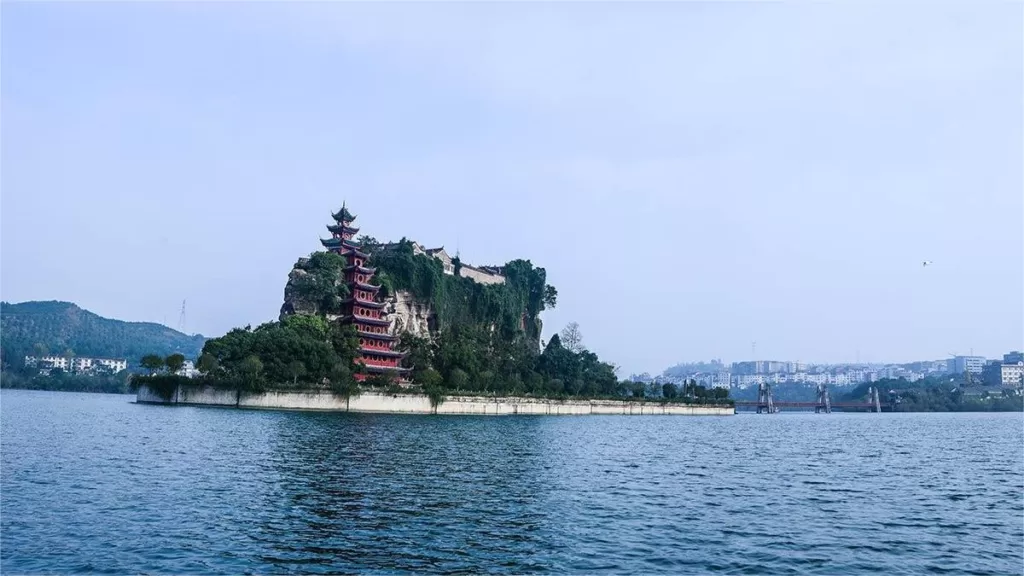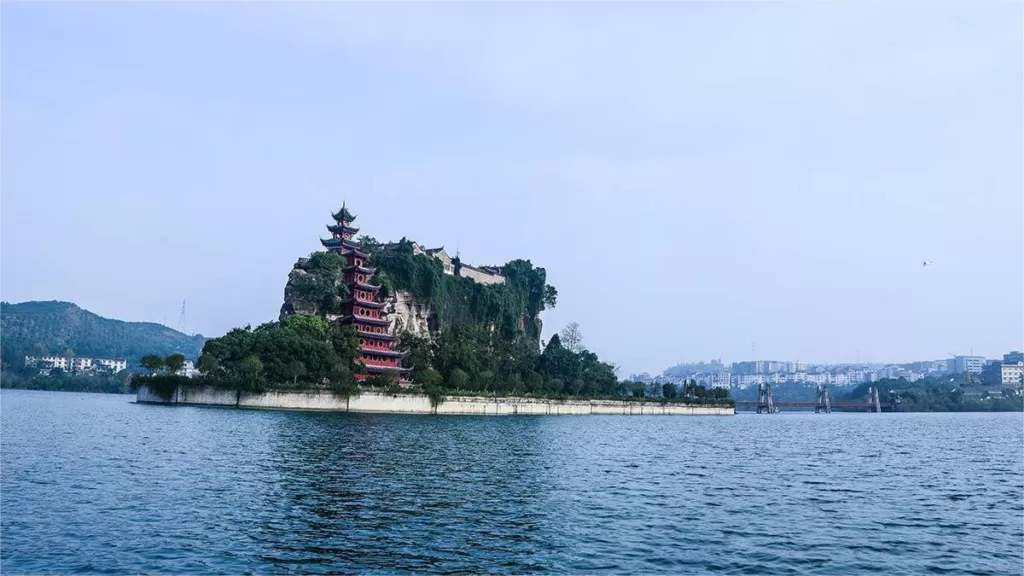Shibaozhai, Chongqing - Ticketpreis, Öffnungszeiten, Transport und Highlights


Shibaozhai Pagoda (石宝寨), located in Chongqing’s Zhong County, on the northern bank of the Yangtze River, is a remarkable cultural and architectural marvel. Perched atop a 211.04-meter high hill, Shibaozhai stands as a testament to ancient Chinese ingenuity and grandeur.
This unique structure is surrounded by water on all sides, enclosed by a massive dike, creating what is often referred to as a “mini Penglai” of the Yangtze River. The main building, known as Shibaozhai Pagoda, rises majestically from the hillside, with its intricate architecture and flying eaves, presenting a truly spectacular sight.
Shibaozhai’s history dates back to the Tang Dynasty, with early structures on the hill for leisure and sightseeing. During the Ming Dynasty, the construction of the Tianzi Hall began under the leadership of the local governor Yin Yu. In the Qing Dynasty, inspired by the flight of an eagle from the foot of Yuyin Mountain, skilled craftsmen built the distinctive tower-shaped pagoda that we see today, solidifying Shibaozhai’s place as a cultural gem and a testament to China’s rich history.
Inhaltsübersicht
- Grundlegende Informationen
- Standort und Transport
- Highlights of Shibaozhai
- Vlog about Shibaozhai
- Nützliche Tipps aus Rezensionen zusammengefasst
Grundlegende Informationen
| Geschätzte Dauer der Tour | Etwa 2 Stunden |
| Ticketpreis | 45 RMB |
| Die Öffnungszeiten | 8.30 - 17.30 |
| Reputation | one of the first national-level scenic spots one of the fifth batch of key cultural heritage protection units National AAAA-level Tourist Attraction Chongqing’s inaugural list of historical gardens |
| Telefon Nummer | 0086-023-85826667 |
Standort und Transport
Shibaozhai is located at the juncture of three counties: Zhong County, Shizhu County, and Wanzhou District in Chongqing, China. It is approximately 38 kilometers from Zhong County’s city center, 52 kilometers from Wanzhou city center, and 55.7 kilometers from Shizhu County’s city center.
To reach Shibaozhai, travelers can start their journey by taking a long-distance bus from Chongqing’s Chaotianmen Transportation Square or board a fast boat from Chaotianmen Port, which will take about 4 hours to reach Zhong County. Upon arriving in Zhong County, visitors can transfer to shuttle buses departing from the Zhong County bus station, with departures every 30 minutes, to reach Shibaozhai.
Highlights of Shibaozhai
Shibaozhai Pagoda

Shibaozhai Pagoda is the centerpiece of the ancient architectural complex in Shibaozhai, consisting of three main sections: the Ancient Fortress Gate, the Pagoda Body, and the Ancient Temple at the Pagoda Top.
The Ancient Fortress Gate resembles a majestic archway, standing at approximately 8 meters in height, constructed with a combination of bricks and stones. It exhibits a unique architectural design, with the middle section being taller than the sides. The gate’s lintel is inscribed with the characters “梯云直上,” which can be translated as “Climbing the stairs to ascend into the clouds.” This inscription symbolizes the idea of ascending to the ninth heaven, inviting visitors to embark on a journey towards enlightenment. The entire mountain gate is adorned with delicate bas-reliefs and clay sculptures, depicting scenes such as five dragons honoring a saint, two lions engaging in playful combat, and Nezha quelling the seas.
The Shibaozhai Pagoda’s main body is a striking all-wooden tower with a vibrant red hue, encompassing a total of 12 stories and standing at an impressive height of 56 meters. This architectural marvel was conceived by skilled local craftsmen, inspired by the flight of eagles spiraling up the Yuyin Mountain. The pagoda is ingeniously built into the natural rock face, taking advantage of the mountain’s slope. It is divided into two sections, with the lower nine floors subtly representing the concept of the nine heavens, and the upper three floors soaring towards the sky. Wooden ladders are placed inside the pagoda to facilitate the movement of visitors between the floors.
One of the most astonishing aspects of the Shibaozhai Pagoda is its construction technique. The ancient builders made use of the natural incline of the rocks, drilling holes and anchoring wooden pillars directly into the stone. This meticulous craftsmanship allowed for seamless integration between wood and stone, as each layer progressively contracts towards the top, and eaves gracefully extend outward, creating a breathtaking spectacle. Notably, the entire structure was assembled without the use of a single iron nail.
The choice of materials for the pagoda is equally remarkable. It primarily utilizes the wood of the Chinese parasol tree, known for its hardness, resistance to termites, and durability. This selection ensures the longevity of the pagoda and preserves its captivating red appearance. Shibaozhai Pagoda stands as a testament to the architectural genius of its creators and is a symbol of China’s rich cultural heritage. It continues to inspire awe and admiration for its breathtaking design and the craftsmanship that went into its creation.
Tianzi Hall

Tianzi Hall, located at the summit of Yuyin Mountain in Shibaozhai, is a historic architectural gem with a rich history dating back over 400 years. It was initially constructed during the Ming Dynasty in the Wanli era and underwent several renovations and expansions during the Qing Dynasty, from Kangxi to Tongzhi reigns, making it one of the oldest surviving structures in Shibaozhai.
The hall is oriented from east to west and is designed as a three-section, four-courtyard complex, comprising the main gate, front hall, central hall, and rear hall. The front hall serves as the Protector Deity Hall, housing the statue of Guan Yu, the revered God of Loyalty and Righteousness, flanked by the “Four Heavenly Kings.” The central hall, known as the Jade Emperor Hall, contains the sculpture of the Jade Emperor, along with various celestial beings from Chinese mythology. Behind the central hall are two side rooms featuring impressive granite stone reliefs depicting scenes like “The Eight Immortals Cross the Sea” and “Birthday Celebration in the Jade Pool.”
Bas-Relief Wall of Guanyu

The bas-relief wall in Shibaozhai is a remarkable creation crafted from white marble, depicting the story of Guan Yu, a prominent figure from the Three Kingdoms period. This exquisite artwork, focusing on Guan Yu’s loyalty, is a manifestation of the vital “loyalty culture” within Chinese history, occupying a significant place in the nation’s development. Notably, Zhong County is the sole region in Chinese history named after “loyalty,” and it has a legacy of stories celebrating unwavering devotion and resistance against external threats. This bas-relief wall serves as a powerful symbol of the enduring spirit of loyalty and resilience, a testament to China’s rich historical heritage.
Duck Cave

Duck Cave, located in front of Tianzi Hall in Shibaozhai, is a natural rock cave with a small opening resembling the mouth of a bowl. Legend has it that this cave is connected to the Yangtze River, and during the transition from spring to summer, mist and clouds often envelop the cave entrance. Curious about where the cave leads, people used to mark the legs of ducks and release them into the cave. Before long, the ducks would reappear in the Yangtze River, leading to the name “Duck Cave.” This intriguing natural feature adds to the mystique and wonder of the Shibaozhai cultural and natural landscape.
Vlog about Shibaozhai
Nützliche Tipps aus Rezensionen zusammengefasst
Sightseeing and Photography: When climbing the tower, reaching the second floor provides an excellent spot to capture beautiful photographs through a circular window. The background features the river, tourist boats, and the mountain city on the opposite side. The higher you go, the better the view. Each floor of the tower also showcases historical figures or stories.
Optionen für das Essen: For dining, Zhongxian Old Street along the river offers a variety of unique restaurants. Along Linjiang Road and Binjiang Road, you can find specialty eateries including hot pot, grilled fish, barbecue, and local cuisine. Linjiang Road resembles Chongqing’s Nanbin Road, offering scenic views of the river and neon-lit bridges, especially enchanting during the night.
Popularity and Crowds: Shibaozhai is considered a lesser-known attraction, even during holidays, meaning there are usually fewer visitors.
Attraktionen in den Bezirken von Chongqing, Attractions in Zhong County Chongqing, Historische Stätten in Chongqing